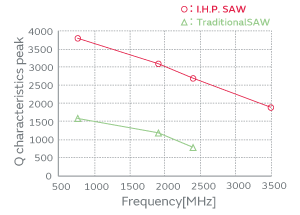(3) High Heat Dissipation
The I.H.P. SAW filters exhibit satisfactory heat dissipation. When there is an input of high power electric signal, the IDT generates heat. The input of more intense signal generates further heat, which may cause a malfunction of devices, including the breakdown of electrodes. The I.H.P. SAW filters can dissipate the heat generated at the electrodes efficiently onto the substrate, which helps reduce an increase in temperature upon startup to less than half of that by traditional SAW filters. The combined effect of low TCF and high heat dissipation stabilizes the response of the filters at high operating temperature.
3. Future Potential
The I.H.P. SAW filters can exhibit satisfactory characteristics over a wide range of frequency spectrum from lower frequency (800 MHz band) to higher frequency (2500 MHz band). In recent development, satisfactory results were obtained for the frequency characteristics in the 3.5 GHz band, which had been considered difficult with traditional SAW filters (the peak value at 3.5 GHz in Fig. 5). The evolution of mobile terminals to further high-speed communications tools is an inevitable path in the future. The I.H.P. SAW filters are products that can be adapted for the challenges to be posed by next-generation communications terminals.

One of the characteristic features of the I.H.P. SAW filters is the degree of freedom in the adjustment of fractional bandwidth. The I.H.P. SAW filters allow filter engineers to choose any fractional bandwidth they like. A band may have a variety of bandwidth from narrow band to broad band. The I.H.P. SAW filters help filter engineers design filters that are optimized for various bands by allowing them to choose desired bands.
Additionally, the I.H.P. SAW filters can be adapted for the requirement of filter miniaturization. The above-mentioned three characteristic features will facilitate substantial miniaturization of the devices as compared with traditional SAW filters. The demand for the miniaturization of filters is expected to be strengthened in the future as the downsizing of mobile terminals advances. In this kind of environment, the I.H.P. SAW filters are ideal products that can provide an advantage in size.
4. Conclusion
The I.H.P. SAW filters offer excellent additional values: The devices provide better characteristics than BAW filters, while using a technology of surface acoustic waves. The requirements for the RF filters are expected to become increasingly severe year by year, reflecting the demand for frequency expansion, further miniaturization, multiband implementation, etc. In this kind of environment, we expect to encounter an increasing number of situations in the future to which only the I.H.P. SAW filters can provide solutions. We do hope that the I.H.P. SAW filters will be core marketing products in Murata’s RF component lineups, and we will devote ourselves to providing our clients with our stable quality products.








